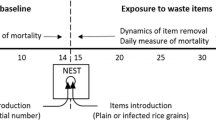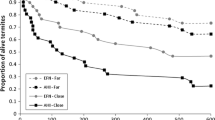Abstract
The intensity of attendance by a honeydew-foraging ant, Lasuis niger, on the red wax scale insect, Ceroplastes rubens, was estimated at different manipulated densities in the field. The time that individual ants were present and the total attendance time (seconds x number of ants) of ants on scale-infested twigs significantly increased as the density of C. rubens increased, i.e. ant attendance was density dependent. To determine the effects of density dependence of ant attendance on parasitism of C. rubens by Anicetus beneficus, we measured parasitism rates in the field at different density levels of C. rubens both with ant attendance and with ants excluded. Parasitism rates were higher when ants were excluded, at each density level. Although the parasitism rate significantly deceased as scale density increased, whether or not ants attended, the difference in parasitism rate between density levels was strikingly less without ant attendance. Therefore, the density-dependent decrease of parasitism rate was more pronounced with ant attendance. Mortality not due to parasitism showed density dependence in both conditions and did not change when ants were excluded. These results indicate that attending ants reduce parasitism and that, as a consequence of the density dependence of ant attendance, the efficiency of reduction of parasitism by ants is enhanced at higher densities of C. rubens.
Similar content being viewed by others
References
Addicott JF (1978) Competition for mutualists: aphids and ants. Can J Zool 56: 2093–2096
Addicott JF (1979) A multispecies aphid-ant association: density, dependence and specific effects. Can J Zool 57: 558–569
Boucher DH (1985) The biology of mutualism: ecology and evolution. Croom Helm, Beckenham
Boucher DH, James S, Keeler KH (1982) The ecology of mutualism. Annu Rev Ecol Syst. 13: 315–347
Breton LM, Addicott JF (1992) Density-dependent mutualism in an aphid-ant interaction. Ecology 73: 2175–2180
Bristow CM (1984) Differential benefits from ant attendance to two species of Homoptera on New York ironweed. J Anim Ecol 53: 715–726
Bristow CM (1991) Are ant-aphid associations a tritrophic interaction? Oleander aphids and Argentine ants. Oecologia 87: 514–521
Buckley RC (1987) Interactions involving plants, Homoptera, and ants. Annu Rev Ecol Syst 18: 111–135
Carroll CR, Janzen DH (1973) Ecology of foraging by ants. Annu Rev Ecol Syst 4: 231–257
Cushman JH, Addicott JF (1989) Intra- and interspecific competition for mutualists ants as a limited and limiting resource for aphids. Oecologia 79: 315–321
Cushman JH, Whitham TG (1989) Conditional mutualism in a membracid-ant association: temporal, age-specific, and density-dependent effects. Ecology 70: 1040–1047
Denno RF, Douglass LW, Jacobs D (1985) Crowding and host plant nutrition: environmental determinants of wing-form in Prokelisia marginata. Ecology 66: 1588–1596
Dreisig H (1988) Foraging rate of ants collecting honeydew or extrafloral nectar, and some possible constraints. Ecol Entomol 13: 143–154
Fritz RS (1982) An ant-treehopper mutualism: effects of Formica subsericea on the survival of Vanduzea arquata. Ecol Entomol 7: 267–276
Henderson G, Jeanne RL (1992) Population biology and foraging ecology of prairie ants in southern Wisconsin (Hymenoptera: Formicidae). J Kans Entomol Soc 65: 16–29
Hölldobler B, Lumsden CJ (1980) Territorial strategies in ants. Science 210: 732–739
Hölldobler B, Wilson EO (1990) The ants. Belknap, Harvard University Press, Cambridge, Massachusetts
Itioka T (1993a) An analysis of interactive webs of scale insects, their host plants and natural enemies. In: Kawanabe H, Cohen JE, Iwasaki K (eds) Mutualism and community organization. Oxford University Press, Oxford, pp 159–177
Itioka T (1993b) Studies on population dynamics and community structures of scale insects on citrus trees (in Japanese). Ph D thesis, Kyoto University
Itioka T, Inoue T (1991) Settling-site selection and survival of two scale insects, Ceroplastes rubens and C. ceriferus, on citrus trees. Res Popul Ecol 33: 69–85
Itioka T, Inoue T (in press) The consequences of ant-attendance to the biological control of the red wax scale insect Ceroplastes rubens by Anicetus beneficus. J Appl Ecol
Itioka T, Inoue T, Ishida N (1992) A ten-year study of population dynamics of citrus pests in the pesticide-reduced orchard. Res Popul Ecol 34: 227–247
Karban R, Myers JH (1989) Induced plant responses to herbivory. Annu Rev Ecol Syst 20: 331–348
Kawai S (1980) Scale insects of Japan in colors (in Japanese). Zenkoku Nôson Kyôiku Kyôkai, Tokyo
McClure MS (1980) Competition between exotic species: scale insects on hemlock. Ecology 61: 1391–1401
Nonacs P, Dill LM (1990) Mortality risk vs. food quality tradeoffs in a common currency: ant patch preferences. Ecology 71: 1886–1892
Ohgushi R (1958) Studies on the host selection by three species of Anicetus wasps (Encyrtidae) parasitic on Ceroplastes scales (Coccidae). Mem Coll Sci Univ Kyoto B 25: 31–38
Ohgushi R (1959) Observation on the ovipositing behavior of a parasitic wasp, Anicetus beneficus Ishii et Yasumatsu (in Japanese with English summary). Jpn J Zool 68: 205–208
Ohgushi R (1969) Ecology of insect pests on Citrus (in Japanese). Nosan-gyoson Bunka Kyokai, Tokyo
Ohgushi R (1986) Geographical and ecological informations on three species of Ceroplastes scales. II. Habitat and key host plant (in Japanese). Jpn J Appl Entomol Zool 30: 147–149
Pontin AJ (1978) The numbers and distribution of subterranear aphids and their exploitation by the ant Lasius flavus Fabr. Ecol Entomol 3: 203–207
Quinet Y, Pasteels JM (1991) Spatiotemporal evolution of the trail network in Lasius fuliginosus (Hymenoptera, Formicidae). Belg J Zool 121: 55–72
Rosengren R, Sundström L (1991) The interaction between red ants, Cinara aphids, and pines. A ghost of mutualism past? In: Huxley CR, Cutler DF (eds) Ant-plant interactions. Oxford University Press. New York, pp 80–91
Sakata H (1994) How an ant decides to prey on or to attend aphids. Res Popul Ecol 36: 45–51
Sudd JH (1983) The distribution of foraging wood ants (Formica lugubris Zett.) in relation to the distribution of aphids. Insectes Soc 30: 298–307
Sudd JH, Sudd ME (1985) Seasonal changes in the response of wood-ants (Formica lugubris) to sucrose baits. Ecol Entomol 10: 89–97
Tachikawa T (1951) Some problems of the introduction of control agents of Ceroplastes rubens (in Japanese). Kankitsu 3: 17–19
Tachikawa T (1983) The place of origin of Anicetus beneficus (Hymenoptera: Encyrtidae) (in Japanese). Agriculture and Horticulture 58: 646
Terayama M, Yamauchi K (1991) Genus Lasius. In: The Myrmecological Society of Japan (ed) A guide for the identification of Japanese ants. II. Dolicoderinae and Formicinae (Hymenoptera: Formicidae) (in Japanese). The Myrmecological Society of Japan, Tokyo, pp 23–29
Traniello JF (1989) Foraging strategies of ants. Annu Rev Entomol 34: 191–210
Veena T, Ganeshaiah KN (1991) Non-random search pattern of ants foraging on honeydew of aphids on cashew inflorescences. Anim Behav 41: 7–16
Wainhouse D, Gate IM, Lonsdale D (1988) Beech resistance to the beech scale: a variety of defenses. In: Mattson WJ, Levieux J, Bernard-Dagan C (eds) Mechanisms of woody plant defenses aginst insects. Search for patterns, Springer, Berlin Heidélberg New York, pp 277–293
Way MJ (1963) Mutualism between ants and honeydew-producing Homoptera. Annu Rev Entomol 8: 307–344
Williams, AG, Whitham TG (1986) Premature leaf abscission: an induced plant defense against gall aphids. Ecology 67: 1619–1627
Author information
Authors and Affiliations
Corresponding author
Rights and permissions
About this article
Cite this article
Itioka, T., Inoue, T. Density-dependent ant attendance and its effects on the parasitism of a honeydew-producing scale insect, Ceroplastes rubens . Oecologia 106, 448–454 (1996). https://doi.org/10.1007/BF00329700
Received:
Accepted:
Issue Date:
DOI: https://doi.org/10.1007/BF00329700




